*현대 오두막, 자연을 품다: Bunkie on the Hill의 지속 가능성 이야기 [ Dubbeldam Architecture + Design ] Bunkie on the Hill
아이엠 페이: "건축은 인간의 삶을 반영하는 거울이다. 우리는 건축물에 눈을 돌리면 그 장소의 정신을 느낄 수 있다."

 |
 |
 |
현대 오두막, 자연을 품다: Bunkie on the Hill의 지속 가능성 이야기 Dubbeldam Architecture + Design-Bunkie on the Hill
캐나다 Muskoka의 고요한 숲 속에 자리 잡은 Bunkie on the Hill은 전통적인 오두막 스타일을 현대적으로 해석한 건축물입니다. Dubbeldam Architecture + Design이 설계한 이 작은 별채는 대가족의 휴식을 위한 공간으로, 자연과의 조화, 지속 가능성을 고려한 디자인이 특징입니다. 특히, 이 프로젝트는 5개의 주요 디자인 상을 수상하여 국제적으로도 그 가치를 인정받았습니다. 수상 내역에는 International Design Award(IDA) 골드상, Architecture Masterprize, Grand Prix du Design 골드상 등이 포함되어 있습니다. 이는 이 건축물이 혁신적인 설계와 지속 가능한 접근을 통해 디자인 업계에서 높은 평가를 받았음을 보여줍니다.
1. 프로젝트 개요
프로젝트명: Bunkie on the Hill
설계자: Dubbeldam Architecture + Design
위치: 캐나다 Muskoka
완공 연도: 2023년
2. 설계 컨셉
이 건물은 A-프레임 형식을 변형하여 현대적으로 해석하였습니다. 두 개의 지붕이 교차하는 형태는 주변의 겹쳐진 암석층에서 영감을 받았으며, 이러한 교차 지붕 구조는 창문을 배치할 수 있는 공간을 제공하여 자연광을 극대화합니다. 특히, 지붕의 교차 구조는 실내로 들어오는 자연광을 극대화하여 내부 공간을 더 밝고 넓게 느끼게 하며, sharp한 지붕 각도를 따라 빛이 반사되어 독특한 그림자와 시각적 라인을 형성합니다. 이는 기능과 미학이 조화된 인상적인 설계 요소입니다.
호수를 향한 높고 좁은 유리 파사드와 숲을 마주한 불투명한 측면은 건물의 양쪽에서 서로 다른 시각적 매력을 제공합니다. 특히, 서쪽 입구 쪽의 삼나무 슬랫은 단순한 미적 장식이 아니라 빛과 그림자의 변화를 통해 공간 경험을 극대화하는 역할을 합니다.
3. 소재 및 질감
외부는 회색 목재 사이딩으로 덮여 있어 주변의 나무들과 자연스럽게 어우러집니다. 이 회색 톤은 시간이 지나면서 자연스럽게 경관에 녹아들게 설계된 것으로, 자연 환경과의 일체감을 강조합니다. 입구 쪽 나무 슬랫은 따뜻한 삼나무로 구성되어 있으며, 서쪽 햇빛이 이를 통해 들어와 시간에 따라 변화하는 그림자를 만들어냅니다. 내부에서는 오크 바닥재, 메이플 합판, 그리고 삼나무 클래딩을 사용하여 자연의 질감을 살리고 있습니다.
4. 빛과 색채
Bunkie의 설계는 자연광을 최대한 활용하도록 만들어졌습니다. 대형 창문은 내부로 빛을 끌어들이며, 지붕의 교차 구조에서 빛이 반사되며 공간 내에 드라마틱한 그림자와 시각적 라인을 형성합니다. 이때 빛과 그림자의 상호작용은 내부 공간을 더 역동적으로 보이게 하는 데 중요한 역할을 하며, 각도와 시간에 따라 변화하는 공간의 시각적 매력을 끌어냅니다. 회색 톤의 외벽과 삼나무의 따뜻한 색감이 균형을 이루며, 실내는 자연광이 풍부하게 퍼져 편안함을 줍니다.
5. 기능과 사용성
이 작은 공간은 효율적으로 설계되어 있습니다. 건물의 다양한 부분에 마련된 수납공간과 벤치들은 실용성을 고려했으며, 공간을 최대로 활용할 수 있도록 도와줍니다. 상부 다락 공간은 업무를 위한 책상과 추가 침실로 사용될 수 있으며, 아래층 거실과 넓은 창문을 통해 자연의 풍경을 만끽할 수 있습니다. 특히 상부 다락에 배치된 책상은 작업 중에도 자연의 경치를 감상할 수 있도록 설계되어, 공간의 용도가 단순 휴식처를 넘어 작업 환경으로도 기능하도록 하고 있습니다.
6. 지속 가능성 및 에너지 효율
지속 가능한 설계는 이 프로젝트의 중요한 요소 중 하나입니다. 외벽은 두꺼운 단열재로 구성되어 있어 R-40 이상의 단열 성능을 자랑하며, 삼중 유리창을 통해 에너지 손실을 최소화합니다. Flitch 빔이라는 구조적 기법을 사용하여 열교 현상을 줄이고, 철골 구조에서도 에너지 효율을 극대화하였습니다. 건물의 기초는 지형에 맞춰 설계되어 폭파 작업 없이 자연 지형 위에 설치되었습니다. 또한, 이 건물은 ICF(단열 콘크리트 폼) 기초를 사용해 에너지 효율을 더욱 높이고, 환경에 미치는 영향을 최소화하였습니다. 사용된 목재는 FSC 인증을 받은 친환경 재료로, 자연과의 연결을 강화하면서도 환경 영향을 최소화하고 있습니다.
글로벌 트렌드와 비교
이 프로젝트는 자연과의 통합을 중시하는 글로벌 건축 트렌드와 잘 부합합니다. 지속 가능한 건축 재료 사용과 에너지 효율적 설계는 전 세계적으로 주목받는 요소이며, Bunkie on the Hill은 자연과의 상호작용을 극대화한 디자인으로, 교차 지붕 구조를 통해 자연광을 실내로 끌어들여 주변 환경과의 연결성을 강화했습니다. 또한, 작은 면적의 공간을 효율적으로 활용하여 소형 주거 공간에서의 기능성과 시각적 확장을 극대화한 좋은 사례입니다.
결론
Bunkie on the Hill은 자연과 건축이 조화롭게 어우러진 사례로, 지속 가능성과 아름다움을 겸비한 건축물입니다. 작지만 효율적인 공간 활용, 현대적 설계 요소, 그리고 친환경 재료의 사용은 이 건물이 미래의 건축 트렌드와 잘 맞아떨어짐을 보여줍니다. 또한, 자연 경관과의 완벽한 통합을 통해 건축물이 시간이 지남에 따라 더욱더 자연 속에 녹아들 수 있도록 설계된 점이 인상적입니다.
Write by ChatGPT & 5osa


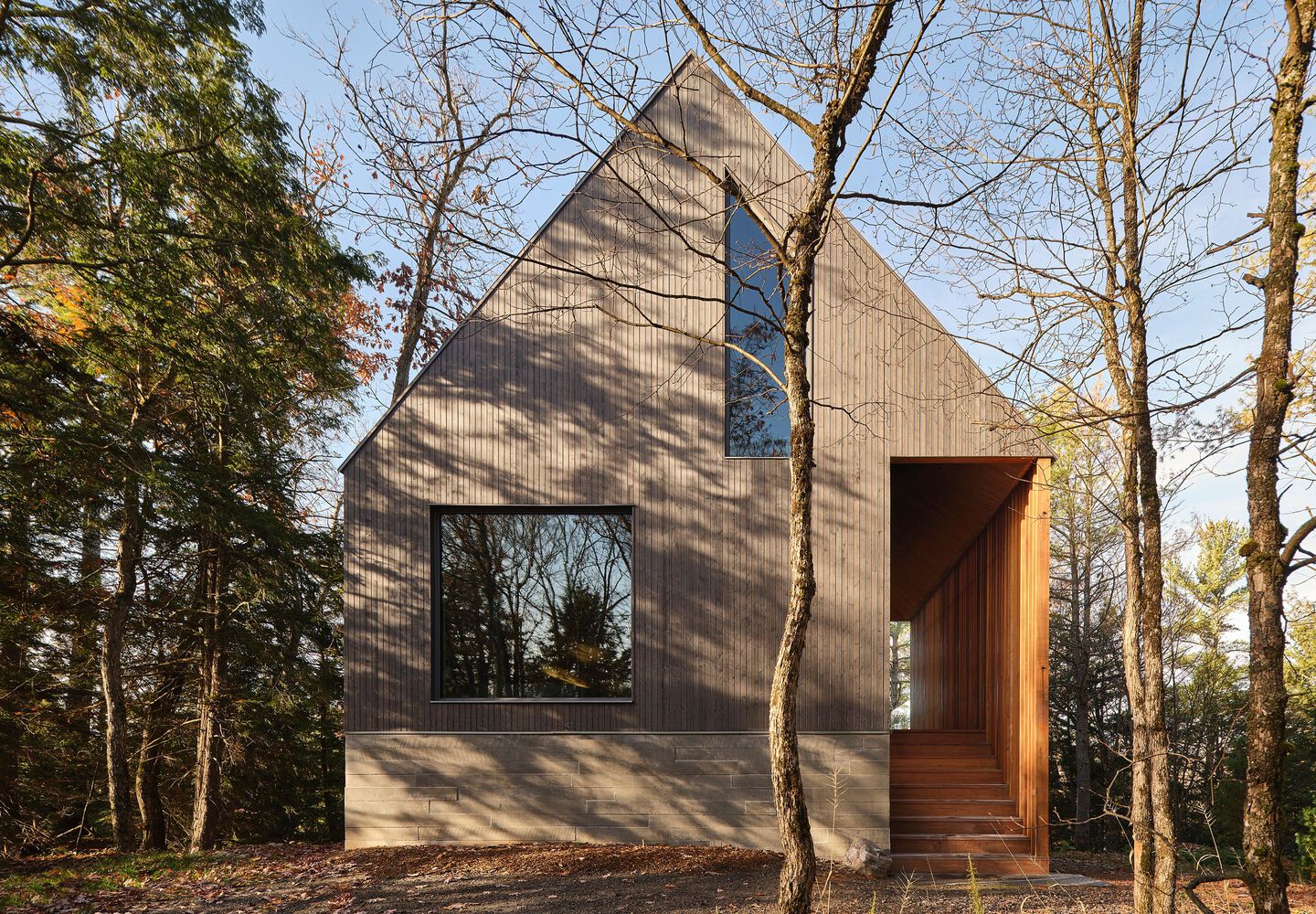

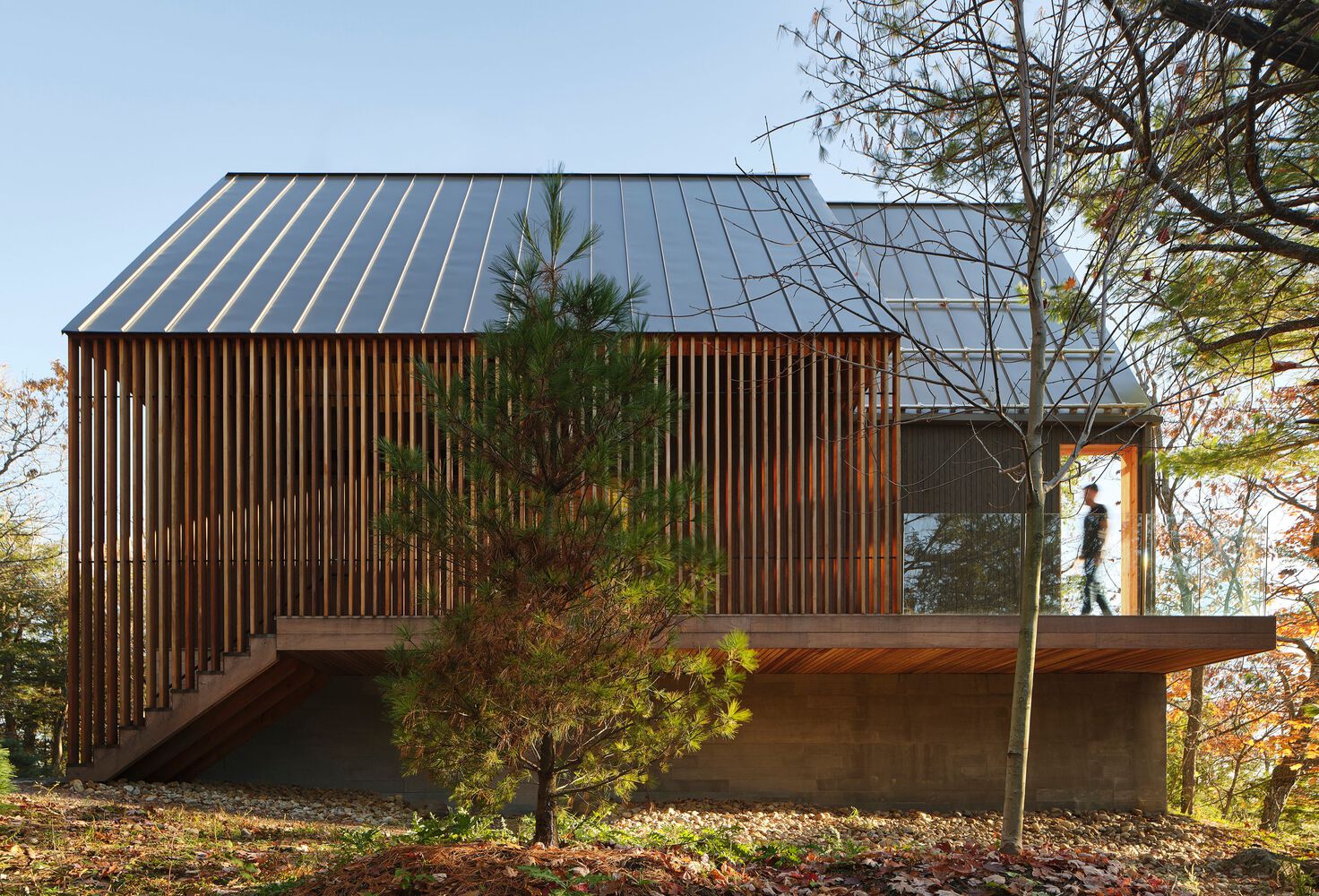


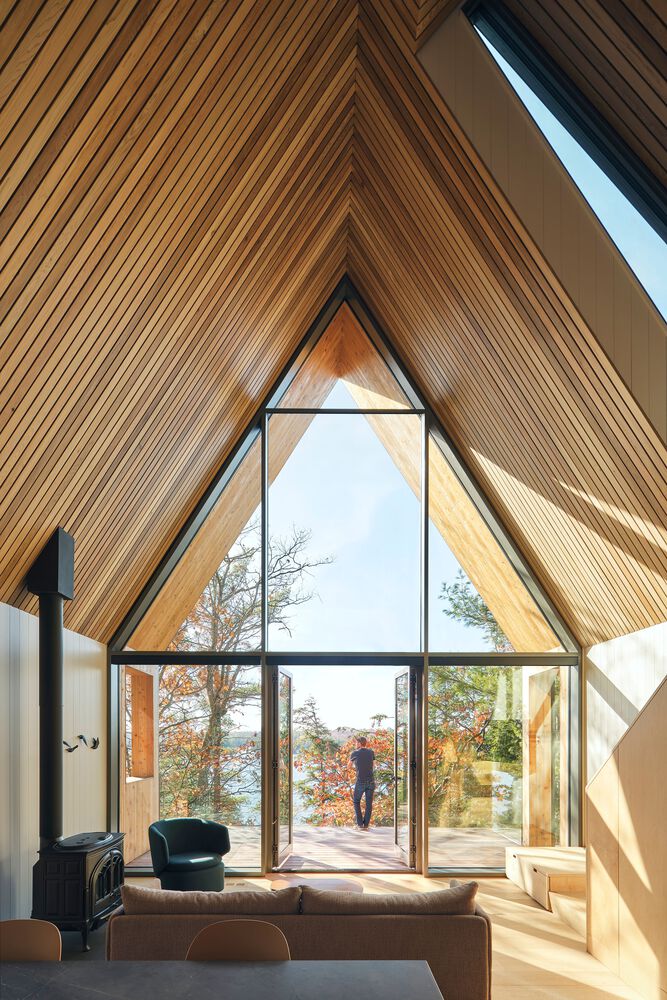

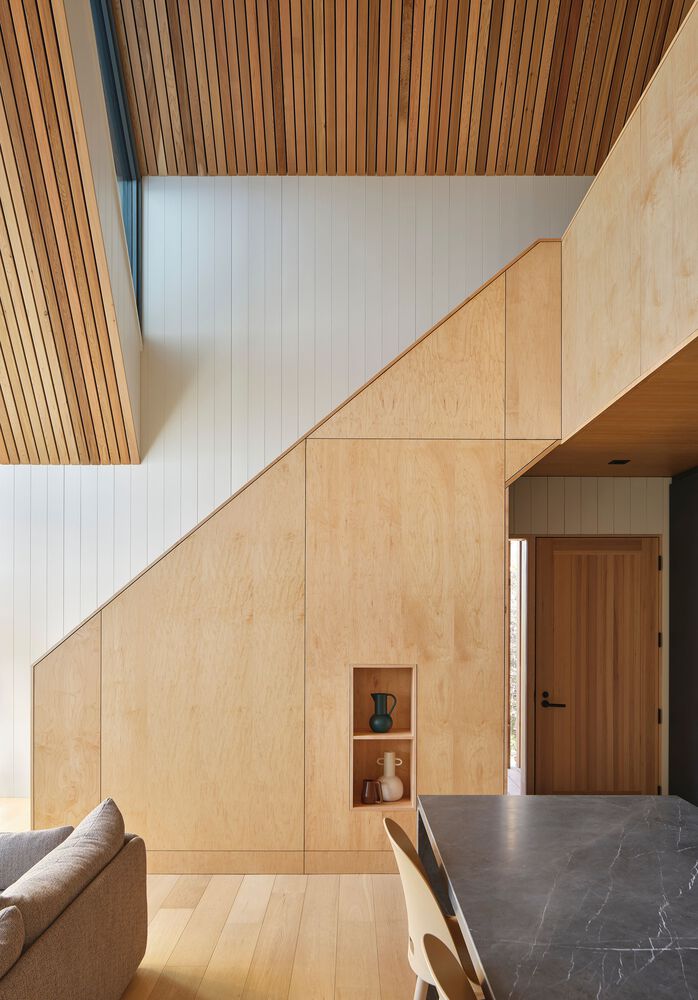






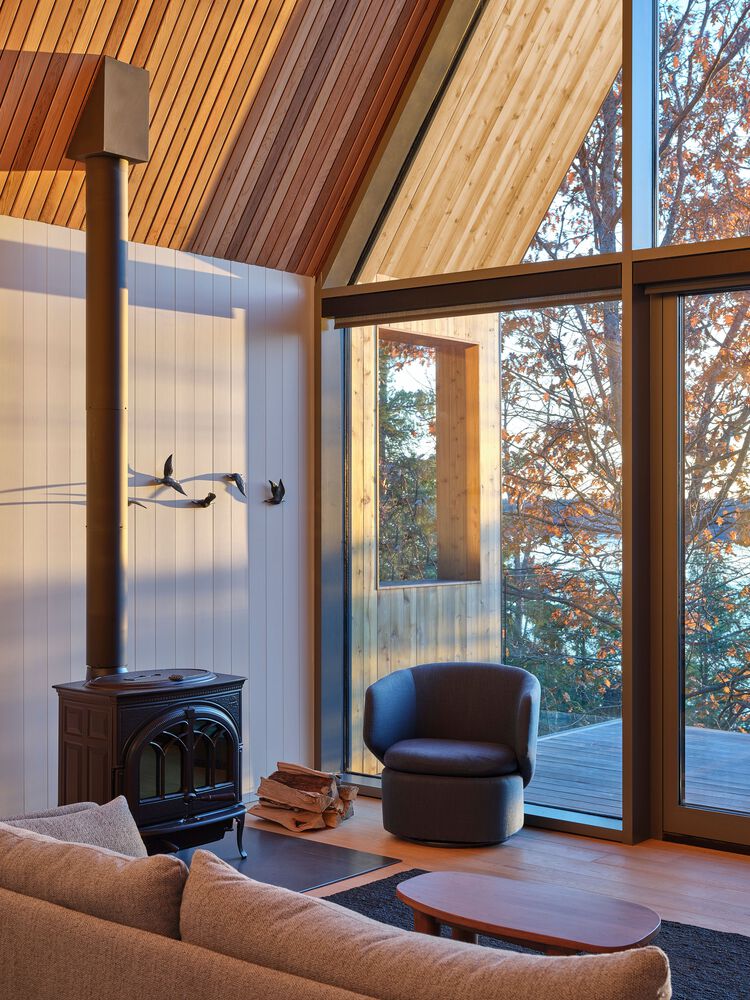


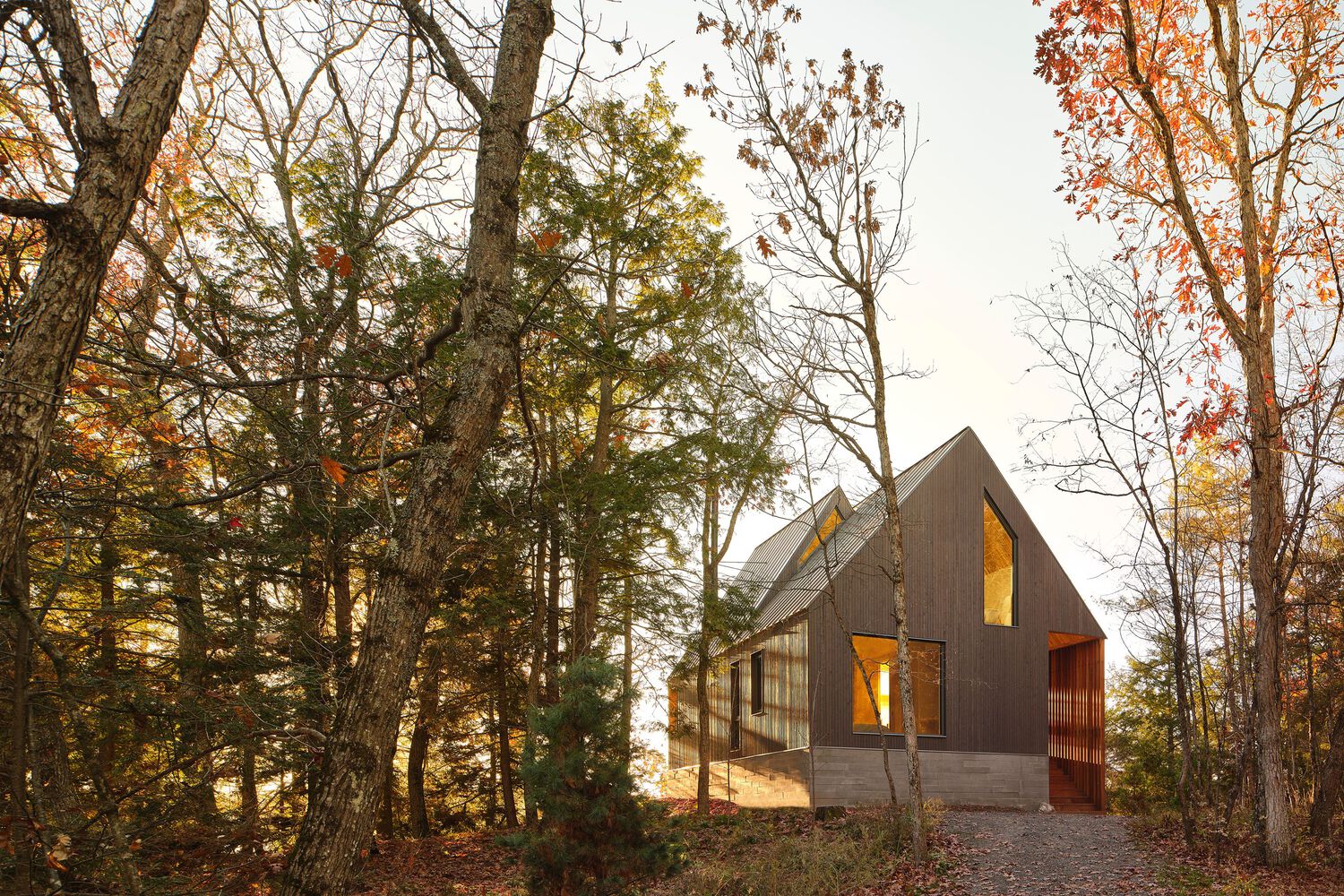
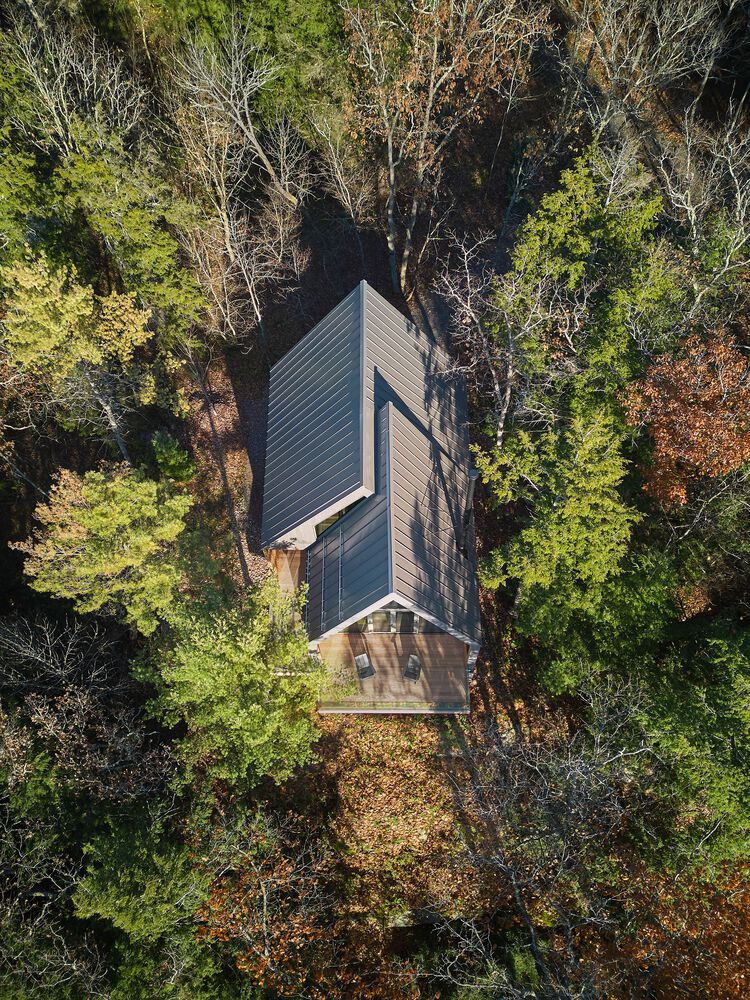
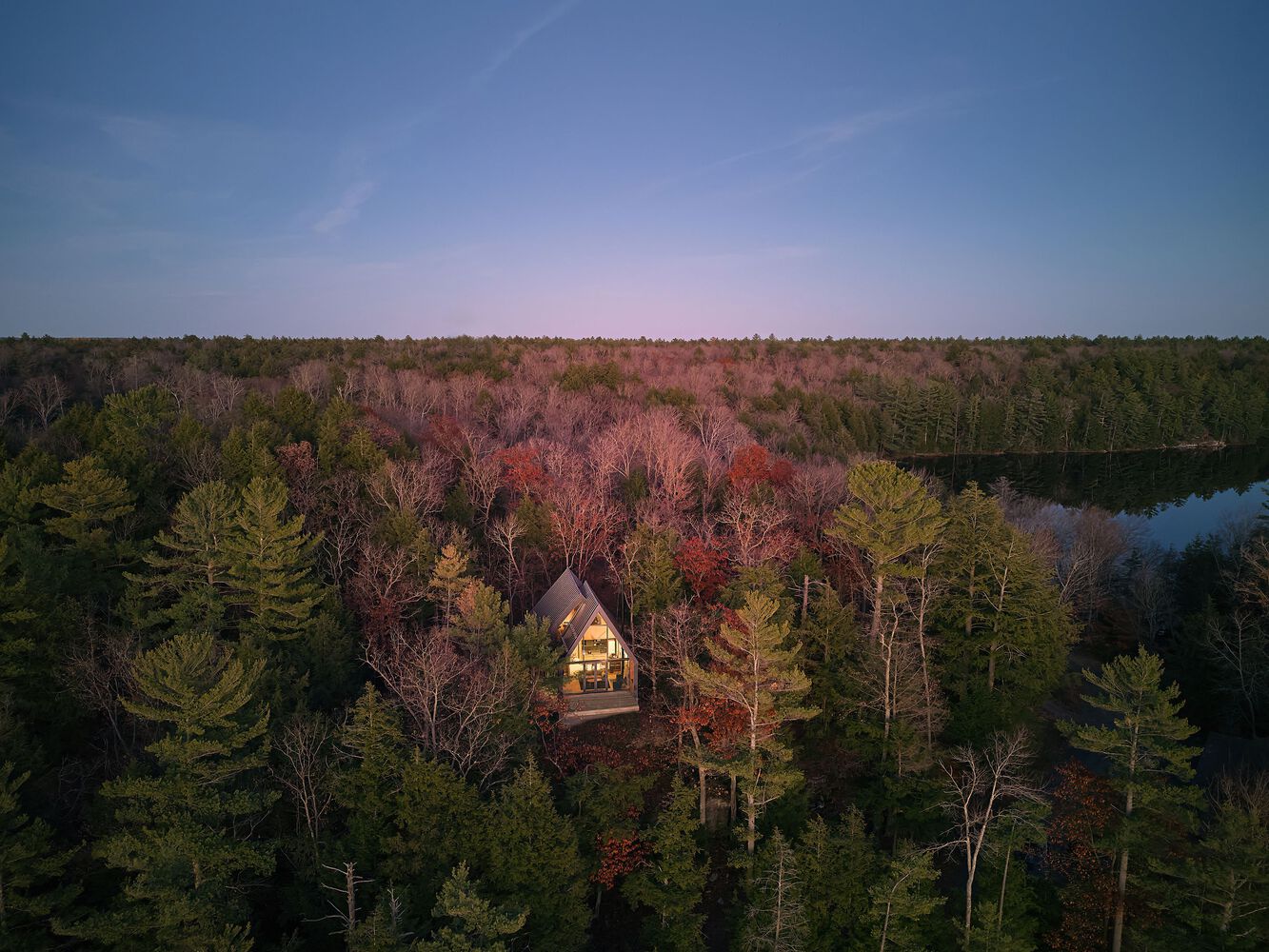

The smallest in a collection of cabins scattered across four family properties, Bunkie on the Hill serves as a space of respite for a family-oriented client in Muskoka. Designed by Dubbeldam Architecture + Design, the Bunkie is tucked into the trees at the top of a steep slope, providing a quiet space away from the action of the multigenerational family cottages below. A contemporary interpretation of the traditional A-frame shape evokes the quintessential cabin in the woods, differentiated by shifted roof volumes. Reminiscent of the overlapping layers of rock in the surrounding landscape, the split roof design features two intersecting gables that create opportunities for window openings where the roof volumes separate.
These geometric windows allow for curated views of the treetops on one side and the lake below on the other and invite natural light to flood the interior of the cabin, reflecting off the sharp roof angles and creating dramatic lines and shadows. The cabin’s split roof design also generates distinct elevations on either side a tall, narrow, glazed façade facing the lake, and a wider, more opaque elevation facing the forest, with a cut-out for a covered entrance on the west side. Located midway along the side façade, the cabin’s entrance features a walkway with a slatted cedar screen on one side, which echoes the tree trunks seen through framed views at each end. The cedar slats are animated by the ever-changing west light that filters through its openings, producing a dynamic interplay of light and shadows that enhance the richness of the material, creating an engaging experience for visitors.
The Bunkie's interior is functional, despite its compact size. Small nooks throughout contain storage shelves or built-in benches. Each interior space is designed to offer framed views of the surrounding forest or the lake below. The upper loft area includes a built in desk with a view down to the living space on the first level and the vast lake beyond, as well as an extra space for sleeping. The bedroom is located at the rear and features a large window that offers immersive views of the forest.
Natural materials were chosen to complement the rustic landscape that surrounds the Bunkie. Greyed wood siding contrasts the natural cedar soffits and screen that frames the entrance, sitting atop the raw, board formed concrete base. Interior materials include oak flooring, maple plywood, and cedar cladding, grounded by dark charcoal window frames, grey stone counters, and furniture that offers moments of color. Principal Heather Dubbeldam describes the variety of wood species that were used to differentiate the various planes in the space: “We used white wallboard to define the interior perimeter walls, internal partitions are clad in maple plywood, and the ceiling is delineated by Western red cedar slats, bringing even more of the surrounding forest inside,” she notes.
Sustainable materials and construction methods were as important to the client as they were to Dubbeldam. The exterior walls have been thickened to serve as a passive insulator – boasting an R-value of over 40 – and include triple glazed windows, making it possible to use a minimal heating system in the crawl space below. Flitch beams were utilized to eliminate any thermal bridges, despite the use of steel framing. To avoid the need for blasting, the Bunkie was raised above grade and its foundation was constructed on top of the natural rock contours, allowing the structure to sit lightly on the landscape. Wood products used are FSC-rated, and the few plumbing and light fixtures are low flow and low energy. Any patina of materials over time is intentional: as time passes the Bunkie blends back into its forested hill setting.
from archdaily